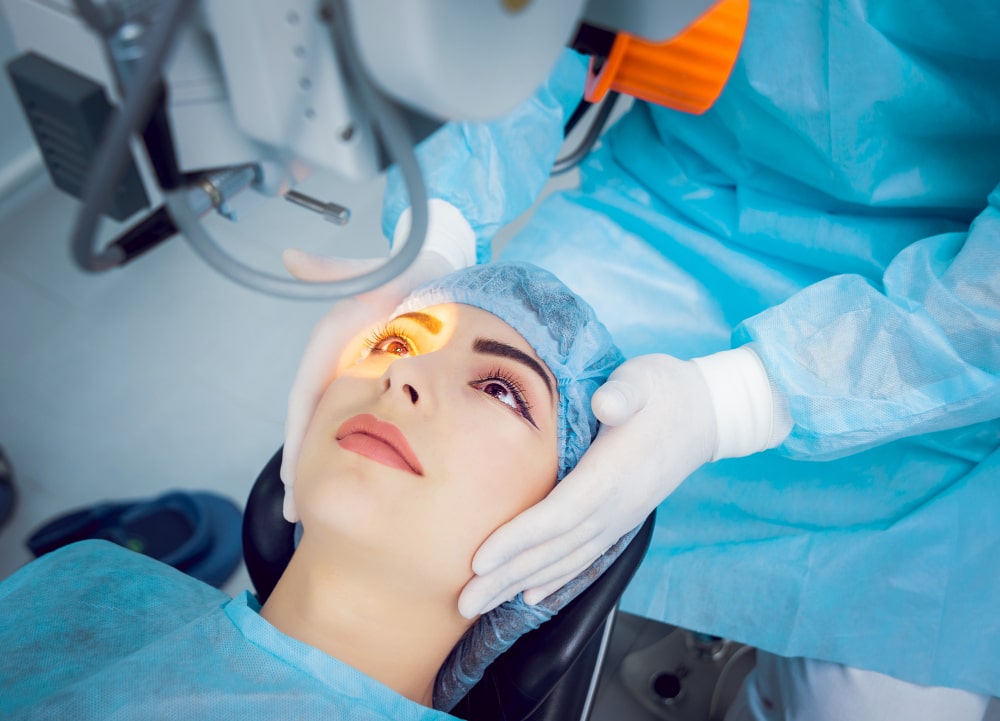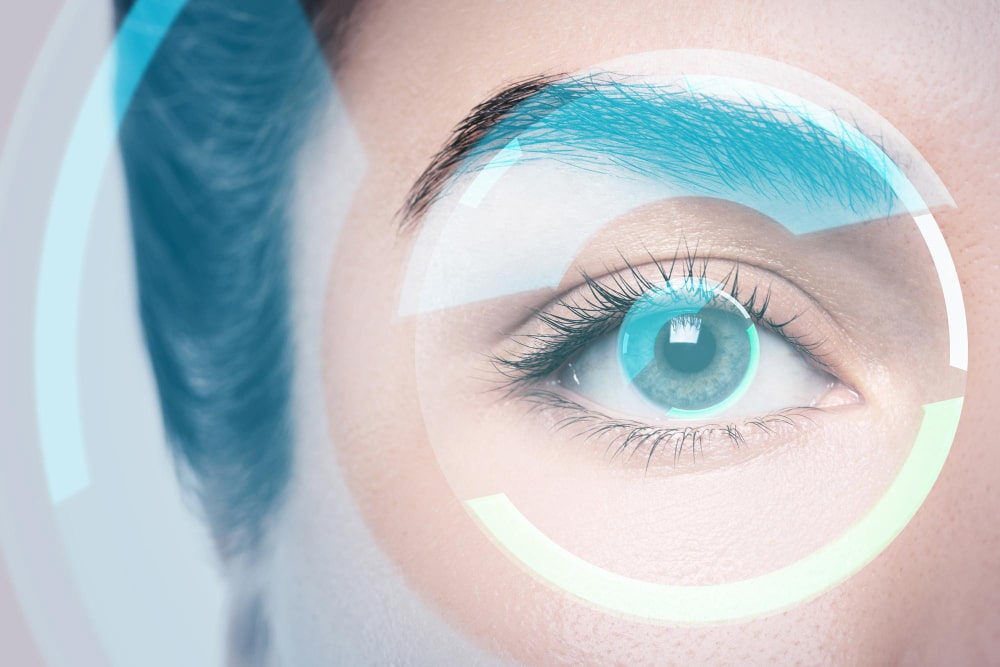Smile laser is a method that gives very good results in the process of non-surgical treatment in eye surgery. It is performed by directly contacting the cornea.
Smile Laser in Türkiye
SMILE laser is a new-generation eye surgery method. It is possible to get rid of glasses and contact lenses with SMILE laser technology, which gives successful results in the treatment of refractive errors such as myopia and astigmatism. Compared to other treatment methods, SMILE laser treatment is less damaging to body tissues and therefore the recovery time is shorter after the application. For many years, traditional methods such as glasses and contact lens treatment have been used to alleviate the symptoms associated with visual defects. With the important developments in health technology in Türkiye, alternative methods such as SMILE laser have started to be preferred in addition to traditional methods in the treatment of visual defects today.
What is SMILE Laser?
Under normal conditions, the light coming to the eye from the outside is refracted in the corneal layer. Then it reaches the pupil and refracts again through the lens located in the eye and focuses on the retinal layer located behind the eye. There are a large number of nerve cells in the retinal layer that are responsible for vision. Thanks to these nerve cells, the light coming from outside is transmitted to the visual center in the brain and an image is formed. If there is any problem in this process until the light reaches the visual center, visual defects such as myopia and hypermetropia occur.
Laser therapy is widely used in the treatment of refractive defects in the eye. The treatment of vision defects with the help of a laser aims to reshape the cornea. There are 3 types of laser treatment commonly used around the world. These are LASIK, LASEK and/or PRK and SMILE (Relex) laser treatments. Smile laser technology, which is the abbreviation of Small Incision Lenticule Extraction, is a relatively new treatment method compared to LASIK and LASEK methods.
Smile laser treatment was approved by the FDA (United States Food and Drug Administration) in 2016 and has been widely used since then, especially in patients with myopia and astigmatism. SMILE surgery helps light refract accurately on the cornea. After this treatment procedure, which requires less surgical intervention compared to the LASIK method, it is seen that the majority of people with visual impairments get rid of glasses and lenses.
Who is SMILE Laser Applied to?
SMILE treatment may be a suitable treatment option for people with myopia and astigmatism. People who are eligible for SMILE treatment can be listed as follows:
- Those who are 22 years of age or older,
- Those whose prescriptions have not changed in the last year,
- Those with myopia between -1 and -10 degrees, and astigmatism below 3 degrees,
- People who do not have another eye disease
Currently, the use of SMILE laser therapy in people with hypermetropia is not approved. For this reason, other treatment options are evaluated in people diagnosed with hypermetropia. In addition, SMILE laser therapy may not be suitable for everyone. The situations in which the use of SMILE therapy is not appropriate are as follows:
- Thin corneal layer,
- Presence of another eye disease such as glaucoma, cataract,
- Wound on the cornea due to any trauma,
- Variable visual impairment,
- Chronic health problems such as diabetes
- Having previously undergone eye surgery,
- Presence of health problems that may adversely affect the healing process,
- Having an infection affecting the eyes
- Pregnancy and breast-feeding
In such cases, other methods that are alternatives to SMILE laser treatment can be used.

In Which Age Range Can Smile Laser Be Applied?
SMILE laser can be applied to adults over the age of 22. However, SMILE treatment may not be appropriate if there is an additional eye disease in people in the advanced age group.
How is SMILE Laser Applied?
In SMILE laser operations, as in all other laser operations, the corneal layer of the eye is operated on. The SMILE method is also performed with the help of femtosecond laser technology. In other words, laser technology that can pulse in a very short time is used during the operation. In the LASIK method, the front part of the cornea is lifted by creating a flap. In the SMILE method, a small incision is made on the anterior surface of the cornea with the help of a femtosecond laser without the need to open the flap. Then, a small incision is made in the deeper layers of the cornea and on the lateral side of the cornea. A tissue called a lenticle is removed from this incision. Thus, the refractive defect in the cornea can be corrected.
Things to Pay Attention to After Smile Laser Treatment
The healing process after SMILE is shorter compared to other methods. Paying attention to the recommendations of the ophthalmologist after the operation can help the healing process to be comfortable. The main points to know about the post-SMILE laser treatment process are as follows:
- A stinging sensation in the eye is normal after the operation. It is expected that this complaint will heal within a few hours.
- Since the corneal layer is treated during the operation, it may be necessary to have a companion with the patient.
- After the procedure, it is necessary to avoid washing and rubbing the eyes for 24 hours.
- The ophthalmologist may prescribe eye drops for you to use after the operation. These drops help to moisturize the eyes and protect them from irritation. For this reason, it is important to use eye drops as recommended by the doctor.
- Patients can return to work and normal activities a few days after the operation. However, it may be necessary to avoid heavy exercises to protect the eyes for a few weeks.
- It is normal to have blurred vision after the operation. Within a few days, the complaint of blurring decreases and patients begin to see more clearly.
Is There Any Eye Dryness After SMILE Laser?
One of the most common complications after laser treatment is dry eye. However, since there is no need to create a flap during the SMILE operation, the nerves on the cornea are less damaged. Accordingly, the risk of dry eyes after SMILE laser is less.
Is Blurred Vision Experienced After SMILE Laser?
Blurred vision may be experienced for a temporary period of time in some patients after SMILE laser treatment. But usually, this condition is short-term and resolves on its own within a few days.

What are the Advantages of SMILE Laser?
Compared to other eye laser surgeries, the SMILE method, which is a new-generation laser technology, has many advantages. The main advantages of the SMILE laser method can be listed as follows:
- Relex SMILE is a less invasive procedure (less damaging to tissues) compared to other methods. Thanks to this, less pain is felt during and after the operation.
- Since it can be performed without the need to create a flap in the cornea, the healing process is faster compared to other methods.
- One of the most important advantages of the SMILE laser is the preservation of the thickness of the corneal layer. In methods such as LASIK and PRK, the creation of a flap on the cornea can cause damage to the cornea and deterioration of its thickness. In the SMILE method, lenticule tissue is removed with only a small incision without the need to create a flap.
- Dryness of the eyes is less common after Relex SMILE operation compared to other methods. In other methods, the creation of flaps on the upper layer of the cornea may cause damage to the nerves, resulting in dry eyes after the operation. Since no flap is created in SMILE technology, the risk of damage to the cornea tissue is less.
What are the Disadvantages of SMILE Laser?
SMILE laser treatment has many advantages, but there are also some disadvantages. Some of the disadvantages of SMILE laser can be listed as follows:
- After the effect of local anesthesia has passed, complaints such as pain and stinging may occur for a while.
- Problems such as redness, and bleeding may be seen at the incision site.
- Rarely, the operation may need to be repeated after SMILE treatment.
The risk of these complications is lower after SMILE laser treatment is performed by an ophthalmologist specialized in their field.
How Long is the SMILE Laser Healing Process?
The healing process after SMILE laser may be different for each patient. Some studies show that better vision is achieved in 99% of patients 6 months after the operation.
The Best Smile Laser Doctors in Türkiye
Türkiye, one of the outstanding countries of health technology, can be preferred for smile laser treatment. Especially in recent years, thanks to its successful doctors, Türkiye has gained significant momentum in the field of eye diseases. In order to learn about the best smile laser doctors in Türkiye, it is important to make an appointment with the doctors of high-tech hospitals providing smile laser services in Türkiye.
Liv Hospital: See life with smiling eyes
Liv Hospital, which provides preventive and therapeutic health services with high quality, also makes a difference in smile laser treatment with its successful doctors. From your initial phone conversation through the end of your treatment, the Liv Hospital International Health Services Team will be by your side. Providing service to visitors from many different nationalities in Türkiye, Liv Hospital employs an experienced team of successful and competent medical doctors who can meet all your health needs. For this reason, Liv Hospital provides health services to you in the most effective way so that you can see life with smiling eyes. You can call us to get detailed information about smile laser treatments. You can get acquainted with the advantages of smile laser treatment in Türkiye and witness the difference of Liv Hospital.



